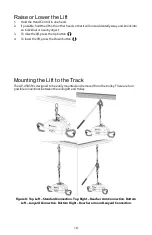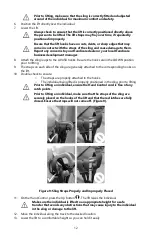
13
14. Grab hold of the lift and move it along the track by gently pushing the lift
or the individual in the sling.
15. When the individual is at the desired location, press the Down button
to lower the
individual to the correct height.
Before you remove the sling loops from the carry bar, check that the
transferred individual is securely supported in the appropriate position.
16. Press the Down button
to lower the lift so the sling straps can be easily removed from
the lift hooks.
Make sure the lift does not contact the individual in the sling.
17. Remove the sling straps from the
lift’s hooks
.
18. Press the Up button
to raise the lift to a safe height.
19. Gently push the lift until it is out of the way of the patient.
20. Remove the sling from the individual.
21. Store the sling in a safe place.
22. Press the Up button
to raise the lift to height where it is out of the way while not in use.
23.
Charge the lift as described in “
WARNING: STRANGULATION HAZARD
On completion of Lift Cycle, ensure that the lift, strap, and hand control are
raised up away from reach of children, toddlers, or anyone not intended to
use the product.
Psychological, mental, and emotional state assessment is key to safe use of a
ceiling lift; ensure that use and storage of the ceiling lift and accessories are
safe for the patient’s mental condition.
While raising a ceiling lift system with or without patient, ensure that the
patient, caregiver, other individuals, furniture, and other items are not at risk
of becoming entangled with the moving lift strap and hand control cable.
Traversing Beam Transfer
If you are using a Handicare X-Y system with a traversing beam, be sure you understand the
traversing beam and how it works in transferring an individual. As shown in Figure 10, the X-Y
system features two parallel support tracks with one traversing beam mounted across them.
Figure 10: Handicare X-Y System Featuring Traversing Beam
The lift can be moved along the traversing beam, and the traversing beam itself can be moved
along the two parallel support tracks. Because of this, an X-Y system provides greater movement
and positioning ability for an individual since the coverage area is everywhere between the
support tracks as opposed to just the area beneath a section of track, as in a single-track












































